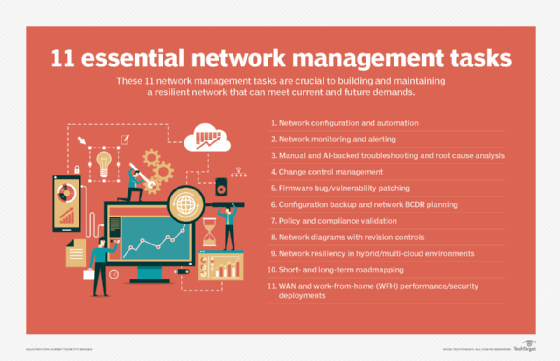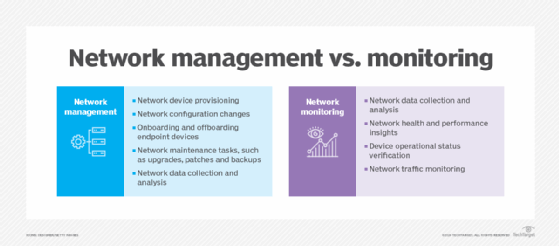Compare network management vs. network monitoring
Network monitoring is a vital part of network management. Both are essential to help network operations teams streamline operations and address potential issues.
Network operations staff work to maintain the health and operational performance of a network infrastructure. As such, they rely on several tools that assist with management and maintenance tasks.
The scope of network management encompasses a wide range of duties that are closely related, such as the following:
- Hardware and software maintenance.
- Network configuration.
- Troubleshooting.
- Network monitoring and alerting.
Network management and network monitoring are two major segments of network operations that provide different benefits yet overlap when it comes to capabilities and use cases. Both ensure networks are reliable and optimized to help teams fix incidents quickly throughout the hardware and software lifecycle.
What is network management?
Network management is an umbrella term that includes the tools network operations staff use to maintain a healthy and high-performing network. Because network security management is usually incorporated into network management, it's common to use network security tools such as firewalls, VPNs and secure access service edge as well.
Network management tools help staff with the following tasks:
- Provision or deprovision network devices. Network tools often add or remove devices to replace failing components, upgrade hardware or scale to meet new business network availability or capacity requirements.
- Automate configuration changes. Network tools can add or make changes to different areas of the network -- such as physical network segments, or parameters such as the security policy, quality of service and Wi-Fi -- with a centralized management dashboard. Many modern network management tools now incorporate AI and automation to eliminate remedial and error-prone tasks.
- Set up and decommission endpoint devices. Networks that incorporate zero-trust network principles require network operations to identify and onboard approved devices. Tasks include device authorization, network segment location and network security policy creation. Network teams must conduct the same process when they offboard devices for decommissioning.
- Facilitate maintenance tasks. Network maintenance takes on many forms, such as network device OS or firmware upgrades, security patches and backups.
- Collect and analyze network log and telemetry data. Log and telemetry data is useful for network optimization and troubleshooting.
- Monitoring and alerting. Network monitoring ensures network components remain active and can travel through traffic. When networking monitoring tools detect any deviations, they can trigger alerts to notify network staff for rapid remediation.

What is network monitoring?
Network monitoring, similar to network observability, is a subset of network management that provides ways to visualize the health and performance of a network. Network monitoring tools often centralize this information in a single dashboard that teams use to identify and remediate network health and performance issues more efficiently.
This article is part of
What is network management?
Network monitoring tools collect data from network equipment, such as routers, switches, wireless access points and load balancers. Network professionals use the collected information to create a visual representation of the network. Common network monitoring protocols include Simple Network Management Protocol, HTTPS and NETCONF.
Network monitoring tools enable network operations teams to identify key details about their networks, such as the following:
- Device and link operational status. Network monitoring tools can monitor devices as a whole, to check if they're operational or not, or individually at a modular level. This includes the operational status of the GPU, CPU and memory usage; power supply status; and individual link or port status.
- Throughput rates over time. Network monitoring tools can monitor traffic throughput rates over time for both ingress and egress traffic. This information is useful in identifying uplinks that are beginning to reach the maximum port speed, which could result in a bottleneck.
- Packet flow statistics. Packet flow data tracks the source, destination and packet type of a specific traffic flow. This information is valuable to determine top talkers and potentially identify routing inefficiencies or malicious traffic, such as a botnet.
- Network service and application health. Network professionals typically monitor supplemental network services -- such as DNS, Dynamic Host Configuration Protocol, Network Time Protocol, RADIUS and routing protocols -- to ensure they remain operational.
Network operations teams can also configure monitoring tools to alert them when the network surpasses a performance threshold and requires investigation. In modern networks, the use of AI and automation can identify issues that the network can then auto-remediate.
Network management vs. network monitoring
Network management covers a wide range of tools and practices that help organizations keep their network healthy and running optimally. Network monitoring is one aspect of network management that provides network operations teams with a real-time and historical view of network health. Network monitoring provides performance indicators that teams can track over time.

However, it can be difficult to manage modern networks without a reliable set of monitoring tools to provide detailed visibility. Previously siloed network monitoring and management tools are merging due to cloud-based dashboards, AI and automation tools. Integrated tools that control and monitor a wide range of network components can simplify network management, as they contain all the essential utilities in one management portal and database.
Andrew Froehlich is founder of InfraMomentum, an enterprise IT research and analyst firm, and president of West Gate Networks, an IT consulting company. He has been involved in enterprise IT for more than 20 years.








